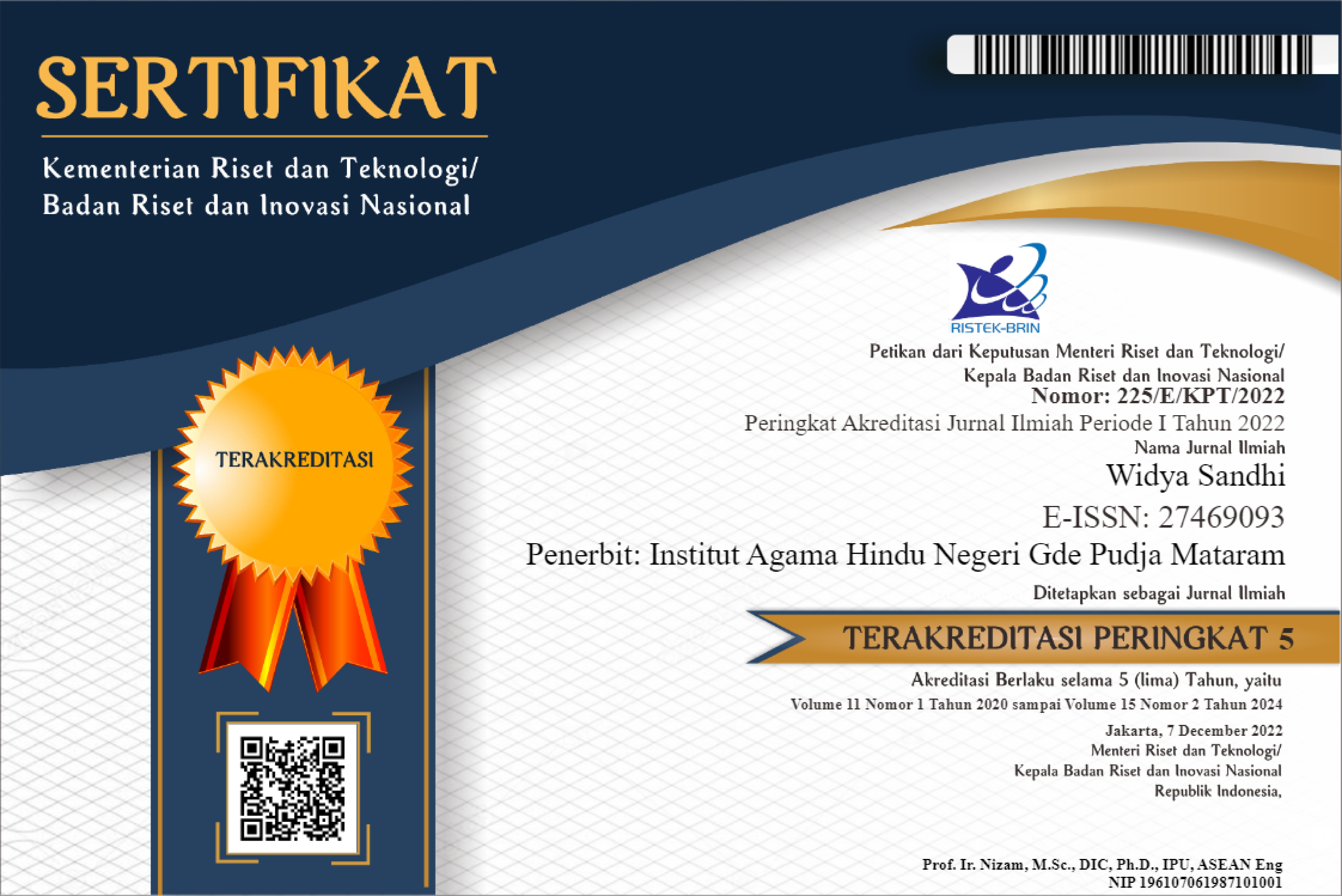UPACARA PITRA YADNYA DI BAJAR SUKA WARDAYA DI TENGAH PUSARAN PERUBAHAN MASYARAKAT SAAT INI
Abstract
This paper is the result of research that aims to analyze the adaptation of the Pitra Yadnya or Ngaben ceremony carried out by the Hindu community in Banjar Suka Wardaya, Babakan Village, Gerung District, West Lombok Regency. This study uses a qualitative descriptive method. The form of adaptation in the implementation of the pitra yadnya ceremony in the Hindu community in the location of research is indicated by a change in the implementation of the pitra yadnya ceremony which previously emphasized the family aspect to become the mass of pitra yadnya ceremony. The implementation of cremation carried out in the family is only assisted by certain people who are related to their family or related to their sidhikara. After the Pitra Yadnya ceremony was held, the community of banjar helped with the ceremonial activities and several sawa (corpses) could be held for the Pitra yadnya ceremony simultaneously. Second, the adaptation process in the implementation of the pitra yadnya ceremony in general goes through three stages. (1) there is an idea from Hindu leaders to carry out the pitra yadnya ceremony en masse. (2) implementing these ideas into concrete actions so that they take the form of mass cremation activities. (3) the continuation of the mass pitra yadnya ceremony because it has benefits for the Hindu community in Banjar Suka Wardaya. Third, there are four meanings of adaptation in the implementation of the pitra yadnya ceremony in Babakan Village. (1) the economic meaning is related to cost reduction. (2) social meaning is related to strengthening social relations between citizens. (3) religious meaning is related to carrying out obligations in accordance with religious teachings. (4) the meaning of education is to increase knowledge in making facilities for the Ngaben ceremony.
References
Dharmayuda, S. I. M.(1995). Kebudayaan Bali: Pra Hindu, Masa Hindu dan Pasca Hindu. Denpasar: Kayumas Agung
Dillistone, F. W. (2002). Daya Kekuatan Simbol ( The Power of Symbols ), Yogyakarta: Kanisius
Geetz, Clifford. (2001). “ Agama Sebagai Sistem Kebudayaan “. Dalam buku Dekontruksi Kebenaran Krtik Tujuh Agama. Terjemahan Inyiak Ridwan Muzir, M. Syukri. Yogyakarta: IRCiSoD
……….(1992) Tafsir Kebudayaan. Terjemahan Fransisco Budi Hardiman. Yogyakarta: Kanisius
Nawawi, Handari.(1983). Metode Penelitian Bidang Sosial. Yogyakarta: Gajah Mada University Press
Kaler, I Guati Ketut. (1993). Ngaben: Mengapa Mayat Dibakar?. Denpasar: Yayasan Dharma Naradha
Suprayogo Iman dan Troboni. (2001). Metodologi Penelitian Sosial-Agama. Bandung: Remaja Rosdakarya
Titib, I Made, (2003), Teologi dan Simbol-Simbol dalam Agama Hindu, Surabaya: Paramita
Triguna, I.B.Y. (2001). “Redifinisi Simbolisme Masyarakat Hindu Di Bali” Denpasar: Laporan Peneltian Unhi

This work is licensed under a Creative Commons Attribution-NonCommercial-ShareAlike 4.0 International License.
Authors who publish with this journal agree to the following terms:
- Authors retain copyright and grant the journal right of first publication with the work simultaneously licensed under a Creative Commons Attribution-ShareAlike 4.0 International License. that allows others to share the work with an acknowledgment of the work's authorship and initial publication in this journal.
- Authors are able to enter into separate, additional contractual arrangements for the non-exclusive distribution of the journal's published version of the work (e.g., post it to an institutional repository or publish it in a book), with an acknowledgment of its initial publication in this journal.
- Authors are permitted and encouraged to post their work online (e.g., in institutional repositories or on their website) prior to and during the submission process, as it can lead to productive exchanges, as well as earlier and greater citation of published work (See The Effect of Open Access).






.jpg)




